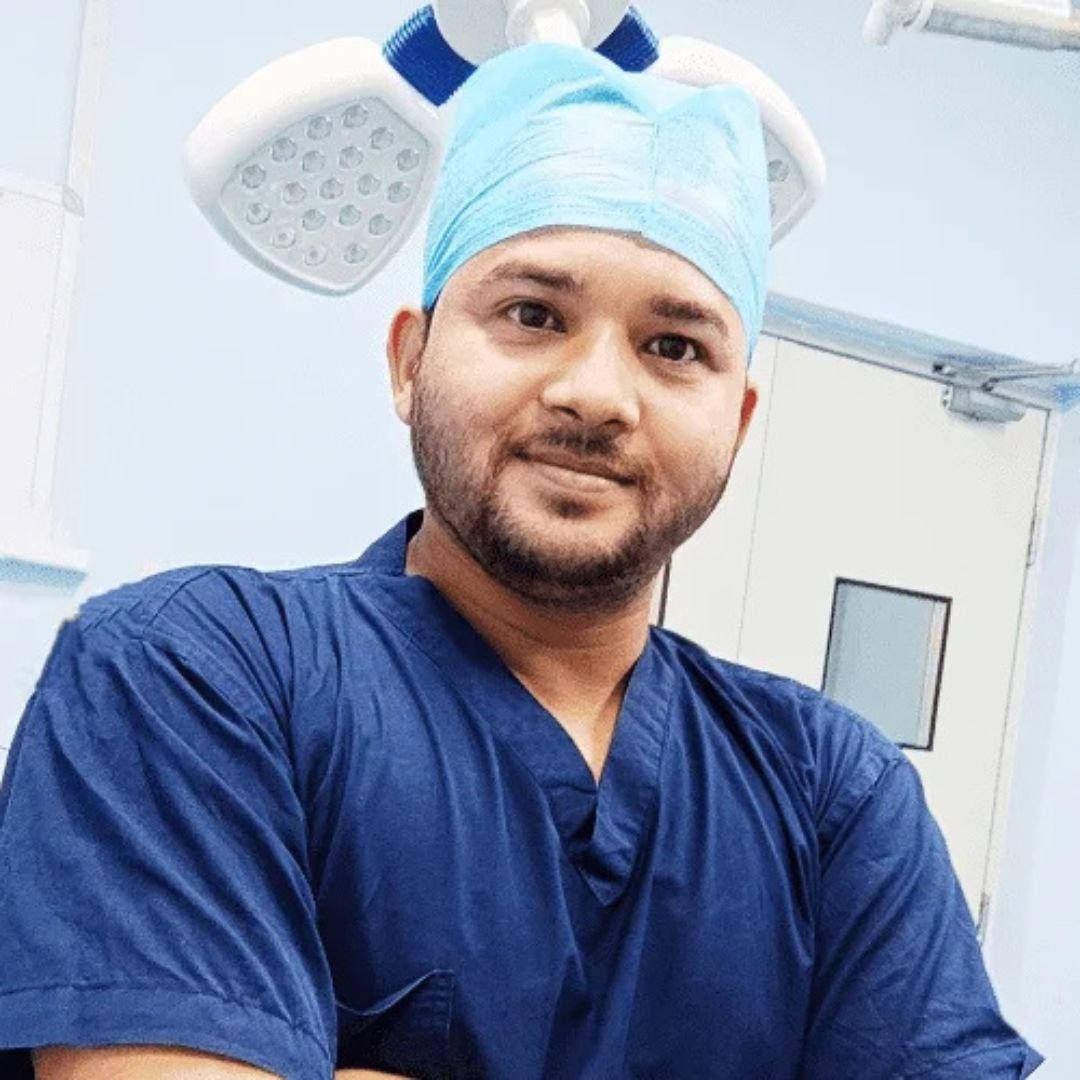ACL Tear Surgery: A Comprehensive Guide
An ACL tear is one of the most common knee injuries, especially among athletes and active individuals. The anterior cruciate ligament (ACL) is a crucial ligament that stabilizes the knee joint. When it tears, it can lead to pain, instability, and limited mobility. While some ACL tears can heal with non-surgical methods, severe cases often require ACL tear surgery to restore full function. At Bharatkare, we specialize in providing advanced treatment options for ACL tears, ensuring personalized care and effective recovery. Whether you’re exploring ACL tear recovery time without surgery or considering surgical intervention, this guide will help you understand your options.
Book Appointments With Our Expert Doctors Near You
- Get consultation for 50+ diseases across India
- In-person and online consultation with experienced doctors
- Extensive medical assistance throughout your treatment


Dr Ashish Sachdeva
MBBS, MS - General Surgery, General Surgeon, Bariatric Surgeon, Laparoscopic Surgeon
4.9/5
20 Years Experience
Vadodara, India

Dr. Tanmay Jain
General Surgeon, Laparoscopic Surgeon and Proctologist
4.9/5
12 Years Experience
Jaipur, India

Dr. Vikram Vasuniya
MBBS, MS (General Surgery) General Laparoscopic & Laser Surgeon, Laser Proctologist
4.9/5
14 Years Experience
Bhopal, India

Dr. Sujeet Kumar Bharti
MBBS, MS (General Surgery) General Laparoscopic & Laser Surgeon, Laser Proctologist
4.9/5
22 Years Experience
Patna, India
What is an ACL Tear?
The anterior cruciate ligament (ACL) is one of the four major ligaments in the knee, connecting the thigh bone (femur) to the shin bone (tibia). It plays a vital role in stabilizing the knee during movements like pivoting, jumping, and sudden stops. An ACL tear occurs when this ligament is overstretched or torn, often due to sports injuries, accidents, or sudden changes in direction.
There are different types of ACL tears, including:
- Partial ACL tear: Only a portion of the ligament is damaged.
- Complete ACL tear: The ligament is fully torn, leading to significant instability.
Symptoms of an ACL tear include:
- A popping sound at the time of injury.
- Severe pain and swelling.
- Difficulty bearing weight on the affected leg.
- A feeling of instability or “giving way” in the knee.
Diagnosing an ACL tear typically involves a physical examination and imaging tests like an ACL tear MRI. This scan helps determine the extent of the injury and whether surgery is necessary.
Disease name
ACL Tear
Surgery name
ACL Reconstruction
Duration
2 Hours
Treated by
Orthopedic Surgeon
ACL and Meniscus Tear: Understanding the Connection
An ACL tear often occurs alongside a meniscus tear, as both injuries are common in high-impact sports. The meniscus is a cartilage that acts as a shock absorber in the knee. When the ACL is torn, the knee becomes unstable, increasing the risk of damaging the meniscus.
Symptoms of a combined ACL and meniscus tear include:
- Increased pain and swelling.
- Locking or catching sensations in the knee.
- Difficulty straightening the knee fully.
Treatment for a combined injury depends on the severity of both tears. In some cases, ACL tear surgery may be required alongside meniscus repair. At Bharatkare, our experts use advanced techniques to address both injuries simultaneously, ensuring a faster and more effective recovery.
Long-Term Effects of ACL Tear Without Surgery
While some patients opt for non-surgical treatment, it’s important to understand the long-term effects of ACL tear without surgery. Without proper intervention, an untreated ACL tear can lead to:
- Chronic knee instability.
- Increased risk of further injuries, such as meniscus tears or cartilage damage.
- Early onset of osteoarthritis.
- Limited mobility and reduced quality of life.
For athletes or individuals with an active lifestyle, these long-term effects can be particularly debilitating. However, non-surgical options like physical therapy and ACL tear exercises can help strengthen the surrounding muscles and improve stability. It’s crucial to consult a specialist to determine the best course of action for your specific condition.
ACL Tear Recovery Time Without Surgery
The ACL tear recovery time without surgery varies depending on the severity of the injury and the patient’s commitment to rehabilitation. For a partial ACL tear, recovery can take anywhere from 6 weeks to 3 months with consistent physical therapy. However, for a complete tear, the knee may remain unstable even after rehabilitation.
Key factors influencing recovery time without surgery include:
- The extent of the tear.
- The patient’s age and overall health.
- Adherence to a structured rehabilitation program.
At Bharatkare, we emphasize the importance of personalized treatment plans to ensure optimal recovery, whether you choose surgical or non-surgical options.
Partial ACL Tear Recovery Time Without Surgery
A partial ACL tear is less severe than a complete tear, and many patients recover without surgery. The partial ACL tear recovery time without surgery typically ranges from 6 weeks to 3 months, depending on the patient’s dedication to rehabilitation.
Rehabilitation for a partial ACL tear often includes:
- ACL tear exercises to strengthen the quadriceps, hamstrings, and calf muscles.
- Low-impact activities like swimming or cycling to maintain fitness.
- Wearing a knee cap for ACL tear to provide additional support during recovery.
While non-surgical treatment can be effective, it’s essential to monitor the knee’s stability. If instability persists, ACL tear surgery may be recommended to prevent further damage.
ACL Tear Exercises: Strengthening Your Knee
Physical therapy plays a crucial role in recovering from an ACL tear, whether or not you undergo surgery. ACL tear exercises are designed to restore strength, flexibility, and stability to the knee. Some effective exercises include:
- Quad sets: Tighten the thigh muscles while keeping the leg straight.
- Hamstring curls: Strengthen the back of the thigh by bending the knee.
- Straight leg raises: Lift the leg while keeping it straight to engage the quadriceps.
- Balance exercises: Improve stability by standing on one leg.
At Bharatkare, our physical therapists create customized exercise programs tailored to your specific needs, ensuring a safe and effective recovery.
Does an ACL Tear Heal on Its Own?
One of the most common questions patients ask is, “Does an ACL tear heal on its own?” The answer depends on the severity of the tear. While a partial ACL tear may heal with proper rest and rehabilitation, a complete tear cannot heal on its own due to the ligament’s limited blood supply.
For patients with a complete tear, ACL tear surgery is often necessary to reconstruct the ligament and restore knee stability. Non-surgical treatment may be an option for those with a sedentary lifestyle or minor tears, but it’s essential to consult a specialist to determine the best approach.
Knee Cap for ACL Tear: Supporting Your Recovery
Wearing a knee cap for ACL tear can provide additional support and stability during recovery. These braces are designed to:
- Reduce stress on the injured ligament.
- Prevent excessive movement that could worsen the injury.
- Provide compression to minimize swelling.
At Bharatkare, we recommend high-quality knee braces tailored to your specific condition. Whether you’re recovering from surgery or managing a partial ACL tear, a knee brace can be a valuable tool in your rehabilitation journey.
Partial ACL Tear MRI: Diagnosing the Injury
An ACL tear MRI is the gold standard for diagnosing both partial and complete tears. This imaging test provides detailed images of the knee’s soft tissues, allowing specialists to assess the extent of the injury. For a partial ACL tear, an MRI can help determine whether non-surgical treatment is sufficient or if surgery is needed.
At Bharatkare, we use state-of-the-art imaging technology to ensure accurate diagnoses and personalized treatment plans. If you’ve experienced a knee injury, an ACL tear MRI can provide valuable insights into your condition.
ACL Ligament Tear Exercises: Restoring Function
For patients with an ACL ligament tear, targeted exercises are essential for restoring function and preventing further injury. ACL ligament tear exercises focus on strengthening the muscles around the knee, improving balance, and enhancing flexibility.
Some effective exercises include:
- Step-ups: Strengthen the quadriceps and improve stability.
- Lunges: Engage the entire lower body while improving balance.
- Wall sits: Build endurance in the thigh muscles.
At Bharatkare, our team of physical therapists will guide you through each exercise, ensuring proper form and technique to maximize your recovery.
ACL Tear Without Surgery: Is It Possible?
Many patients wonder if it’s possible to manage an ACL tear without surgery. While non-surgical treatment can be effective for minor tears or patients with a sedentary lifestyle, it’s not suitable for everyone. Factors to consider include:
- The severity of the tear.
- Your activity level and lifestyle.
- The knee’s stability after rehabilitation.
At Bharatkare, we provide comprehensive evaluations to help you decide whether non-surgical treatment or ACL tear surgery is the best option for your needs.
Understanding ACL Tear Surgery: What to Expect
ACL tear surgery is a common procedure designed to reconstruct the torn ligament and restore knee stability. The surgery involves replacing the damaged ACL with a graft, typically taken from the patient’s hamstring, patellar tendon, or a donor. At Bharatkare, we use advanced surgical techniques to ensure minimal discomfort and faster recovery. If you’re considering ACL tear surgery, here’s what you need to know about the procedure, recovery, and outcomes.
Types of ACL Tear Surgery
There are several types of ACL tear surgery, each tailored to the patient’s specific needs. The most common techniques include:
- Autograft: Using a tendon from the patient’s own body, such as the hamstring or patellar tendon.
- Allograft: Using a donor tendon, which is ideal for patients who may not have suitable tendons for an autograft.
- Arthroscopic surgery: A minimally invasive procedure that uses small incisions and a camera to guide the surgeon.
The choice of technique depends on factors like the patient’s age, activity level, and the surgeon’s recommendation. At Bharatkare, our experts will guide you through the options to ensure the best possible outcome.
ACL Tear Surgery Cost: Factors to Consider
One of the most common questions patients have is about the ACL tear surgery cost. While the exact cost varies depending on several factors, it’s important to understand what influences the price. Key factors include:
- The type of graft used (autograft vs. allograft).
- The surgeon’s experience and expertise.
- The facility where the surgery is performed.
- Post-operative care and rehabilitation.
For those considering ACL tear surgery cost in India, Bharatkare offers affordable and transparent pricing without compromising on quality. To get a detailed estimate, feel free to contact us for a personalized consultation.
Preparing for ACL Tear Surgery
Proper preparation is essential for a successful ACL tear surgery. Here’s what you can expect during the pre-surgery phase:
- Medical Evaluation: Your surgeon will conduct a thorough evaluation, including an ACL tear MRI, to assess the extent of the injury and plan the procedure.
- Pre-Surgery Instructions: You may be asked to stop taking certain medications, avoid eating or drinking for a specific period before surgery, and arrange for post-surgery transportation.
- Physical Therapy: Some patients undergo pre-surgery physical therapy to strengthen the knee and improve surgical outcomes.
At Bharatkare, we provide detailed pre-surgery guidelines to ensure you’re fully prepared for the procedure.
What Happens During ACL Tear Surgery?
ACL tear surgery is typically performed under general or regional anesthesia and takes about 1-2 hours. Here’s a step-by-step overview of the procedure:
- Incision: The surgeon makes small incisions around the knee.
- Graft Harvesting: If an autograft is used, the surgeon removes a tendon from another part of the body.
- Tunnel Creation: Small tunnels are drilled into the thigh and shin bones to position the graft.
- Graft Placement: The graft is threaded through the tunnels and secured with screws or other fixation devices.
- Closure: The incisions are closed, and the knee is bandaged.
The procedure is minimally invasive, and most patients can go home the same day.
Recovery After ACL Tear Surgery
Recovery after ACL tear surgery is a gradual process that requires patience and dedication. Here’s what you can expect:
- Immediate Post-Surgery: You’ll be monitored for a few hours before being discharged. Pain and swelling are common, but medication can help manage discomfort.
- First Few Weeks: You’ll need to use crutches and wear a knee cap for ACL tear to protect the knee. Physical therapy will begin to restore range of motion.
- 3-6 Months: As the knee heals, you’ll progress to more advanced ACL tear exercises to rebuild strength and stability.
- 6-12 Months: Most patients can return to sports or high-impact activities after 9-12 months, depending on their progress.
At Bharatkare, we provide comprehensive post-surgery care, including personalized rehabilitation plans, to ensure a smooth recovery.
Benefits of ACL Tear Surgery
ACL tear surgery offers several benefits, including:
- Restored knee stability and function.
- Reduced risk of further injuries, such as meniscus tears or cartilage damage.
- Improved quality of life for active individuals.
- Prevention of long-term complications like osteoarthritis.
For athletes and individuals with an active lifestyle, ACL tear surgery is often the best option for regaining full mobility and returning to their favorite activities.
Risks and Complications of ACL Tear Surgery
While ACL tear surgery is generally safe, it’s important to be aware of potential risks and complications, such as:
- Infection at the surgical site.
- Blood clots or deep vein thrombosis (DVT).
- Graft failure or re-tear of the ACL.
- Stiffness or limited range of motion in the knee.
At Bharatkare, we take every precaution to minimize these risks, from using advanced surgical techniques to providing thorough post-operative care.
ACL Tear Surgery for Athletes
Athletes are particularly prone to ACL tears due to the high-impact nature of their activities. For athletes, ACL tear surgery is often the best option for returning to peak performance. The surgery not only restores knee stability but also reduces the risk of future injuries.
At Bharatkare, we specialize in sports medicine and understand the unique needs of athletes. Our team works closely with patients to ensure they can safely return to their sport as quickly as possible.
ACL Tear Surgery for Non-Athletes
While athletes are more likely to sustain ACL tears, non-athletes can also benefit from ACL tear surgery. For individuals with a sedentary lifestyle, surgery may not always be necessary. However, if the knee remains unstable despite non-surgical treatment, surgery can significantly improve quality of life.
At Bharatkare, we evaluate each patient’s unique circumstances to determine the best course of action.
ACL Tear Surgery in India: Why Choose Bharatkare?
India has emerged as a leading destination for ACL tear surgery, thanks to its world-class medical facilities and affordable costs. At Bharatkare, we combine advanced technology with expert care to provide the best possible outcomes for our patients. Whether you’re a local resident or an international patient, you can trust us for:
- Experienced surgeons with a proven track record.
- State-of-the-art facilities equipped with the latest technology.
- Personalized care tailored to your specific needs.
- Transparent pricing and no hidden costs.
If you’re considering ACL tear surgery cost in India, Bharatkare is your trusted partner for quality and affordability.
Post-Surgery Rehabilitation: The Key to Success
Rehabilitation is a critical component of recovery after ACL tear surgery. At Bharatkare, we emphasize the importance of a structured rehabilitation program that includes:
- ACL tear exercises to rebuild strength and flexibility.
- Balance and coordination training to restore stability.
- Gradual progression to high-impact activities.
Our team of physical therapists will work closely with you to ensure a safe and effective recovery.
ACL Tear Surgery vs. Non-Surgical Treatment
Deciding between ACL tear surgery and non-surgical treatment can be challenging. While surgery is often recommended for active individuals or those with complete tears, non-surgical options like physical therapy and ACL tear exercises may be sufficient for minor tears or less active patients.
At Bharatkare, we provide detailed consultations to help you make an informed decision based on your specific condition and lifestyle.
ACL Tear Surgery: Success Rates and Outcomes
The success rate of ACL tear surgery is generally high, with most patients regaining full knee stability and function. However, the outcome depends on several factors, including:
- The patient’s commitment to rehabilitation.
- The surgeon’s skill and experience.
- The type of graft used.
At Bharatkare, we pride ourselves on achieving excellent outcomes for our patients, thanks to our expertise and personalized approach.
ACL Tear Surgery: Advanced Techniques and Innovations
Advancements in medical technology have revolutionized ACL tear surgery, making it safer, more effective, and less invasive. At Bharatkare, we stay at the forefront of these innovations to provide our patients with the best possible care. Here’s a look at some of the advanced techniques used in ACL tear surgery:
- Arthroscopic Surgery: This minimally invasive technique uses a small camera and specialized instruments to perform the surgery through tiny incisions. It reduces scarring, minimizes pain, and speeds up recovery.
- Double-Bundle ACL Reconstruction: This technique reconstructs both bundles of the ACL, providing better stability and mimicking the natural anatomy of the knee.
- All-Inside ACL Reconstruction: A newer technique that uses smaller incisions and preserves more of the patient’s natural tissue, leading to faster healing.
These innovations have significantly improved the outcomes of ACL tear surgery, allowing patients to return to their normal activities sooner.
FAQ
You Can Find All Answers Here
Understanding the pros and cons of different graft options can help you make an informed decision.
Choosing a surgeon with extensive experience and a proven track record can increase the likelihood of a successful outcome.
Knowing what to expect during recovery can help you plan and set realistic goals.
Being aware of the risks can help you prepare and take necessary precautions.
Understanding the rehabilitation process can help you commit to the necessary exercises and activities.
Knowing the timeline for returning to your favorite activities can help you stay motivated during recovery.
Getting detailed pre-surgery instructions can help ensure a smooth procedure and recovery.
Understanding the ACL tear surgery cost in India and what it covers can help you plan financially.
Knowing the warning signs can help you seek prompt medical attention if needed.
Understanding the long-term outcomes can help you make informed decisions about your treatment and lifestyle.
Quick Links
Popular Surgeries
Find Us
© Copyright BharatKare 2025. All Right Reserved.



